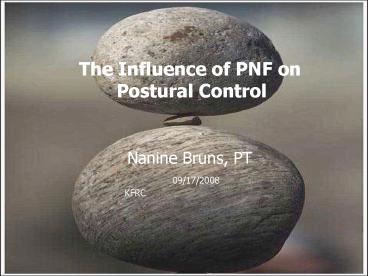The influence of PNF on Postural Control PowerPoint PPT Presentation
1 / 17
Title: The influence of PNF on Postural Control
1
The Influence of PNF on
Postural Control
Nanine Bruns, PT
09/17/2008
KFRC
2
What is Postural Control?
- ? The postural control system is keeping the
projection of the centre of mass within the
limits of the supporting area. - ? Normal postural reflex activity forms the
necessary backround for normal movements and for
functional skills
3
The purpose of postural control
- It has two main functions - build up and
maintain posture against gravity - -
active control of body alignment and tone with -
respect to gravity, support surface, visual en- -
vironment and internal references. - ?The postural control is subcortically controlled
and automatic - ?Postural Control is active during and before a
movement is performed. - ?The normal postural reflex mechanism consists of
a great number of dynamic - postural reactions which work together,
reinforce each other and interact for - the purpose of protection against falling and
against injury to muscles and joints
4
Postural control consists of many subcomponents
Biomechanical Constrains
Movement Strategies
Cognitive Processing
Postural Control
Sensory Strategies
Control Of Dynamics
Orientation In Space
( Fay B. Horak, 2006 )
5
The postural control system The postural control
system operates by controlling the connection
between the sensory /musculoskeletal system and
CNS. ?afferent information suplied to the
postural control system collectively comes
from - visual - vestibular -
somatosensory inputs ?Each sense provides the
CNS with specific information about position and
motion of the body
6
- Somatosensory input
- - provides information concerning the orientation
of body parts to one an- - other and to the support surface.
- Vision
- - it measures the orientation of the eyes and
head in relation to the surrounding objects - Vestibular
- supplies information that measures gravitational,
linear, and angular accelerations of the head in
relation to inertial space. - ?It does not provide orientation information in
relation to external objects
7
(No Transcript)
8
Additional systems influencing postural control
?Internal representations important for
mapping of sensation to action and higher
level processes for adaptive and anticipatory
aspects of postural control ?Anticipatory
mechanisms the CNS forms a representation of
what sensory and motor actions are needed to
accomplish a task ?Anticipatory aspects of
postural control demands are based on previous
experience and learning ?Adaptive
mechanisms involves modifying sensory and motor
systems in response to changing task and
environment demands
9
Choice of body movement
Determination of body position
Compare,select,and combine senses
Select and adjust Muscle contractile pattern
Vision
Vestibular
Somatosensation
Ankle muscles
Thigh muscles
Trunk muscles
Neck muscles
Environmental interaction
Generation of body movement
( Bryan L. Riemann, Kevin M. Guskiewicz )
10
- Postural Control components and PNF
- When we see all these underlying systems for
postural control, you - can see how many of them are missing in the
postural control of patients - Looking at the PNF philosophy and basic
principles and the components of - postural control, you can see that we can
influence those components in our - treatments.
11
Postural Control and PNF
- Systems for postural control
- Musculoskeletal components
- Sensory strategies
- Visual
- Basic principles Philosophy
- pt Pos.?good alignment, res-
- pect Pat. ROM muscle recruitment
- Visual cuing ?facilitate coordination of head and
trunk with movement - Vision cues movement direction
- Relationship between eye movement, head movement
postural adjustment
12
- Somatosensory inputs
- (proprioceptive, cutaneous, joint receptors)
- Vestibular Inputs
- Proprioceptive Input
- ?manual contact?stimulates skin receptors
pressure receptors - ?pt Pos.
- ?Traction/Approximation?joint receptors
- ?Quick strech
- pt Pos.?influence of gravity and
reflexes(e.g.Tonic labyrinthine)
13
- Anticipatory mechanisms
- Adaptive mechanisms
- Repetition of max. response promotes motor
learning - Movement directed toward a specific functional
goal specific and purposeful - Functional goals ( change environment task to
adapt with system to new position) - pt Pos.
- Use of stronger body parts to influence weaker
parts
14
- Internal representation
- Proprioceptive inputs
- ?manual contacts
- ?pt Pos
- Tapping a maximal response to increase motor and
sensory awareness - Repetition of max. response
- Movement directed toward a specific functional
goal, specific and purposeful
15
- Summary
- Postural control results from a complex
interaction - between many underlying systems that work
cooperatively - to control the bodys position in space.
- It is determined by the functional task and the
environment. - By using appropriate PNF components we can
improve some or most of the - postural control deviations.
16
- References
- Fay B. Horak, 2006, Postural orientation and
equilibrium what do we - we need to know about neural control of balance
to prevent falls? - Bryan L.Riemann, Kevin M.Guskiewicz,
Contribution of the Peripheral - Somatosensory System to Balance and Postural
Equilibrium - Book Control of Posture and Balance
- Berta Bobath, 1990 Third Edition, Adult
Hemiplegia, Evaluation and - Treatment
17
Thank you for your
attention

